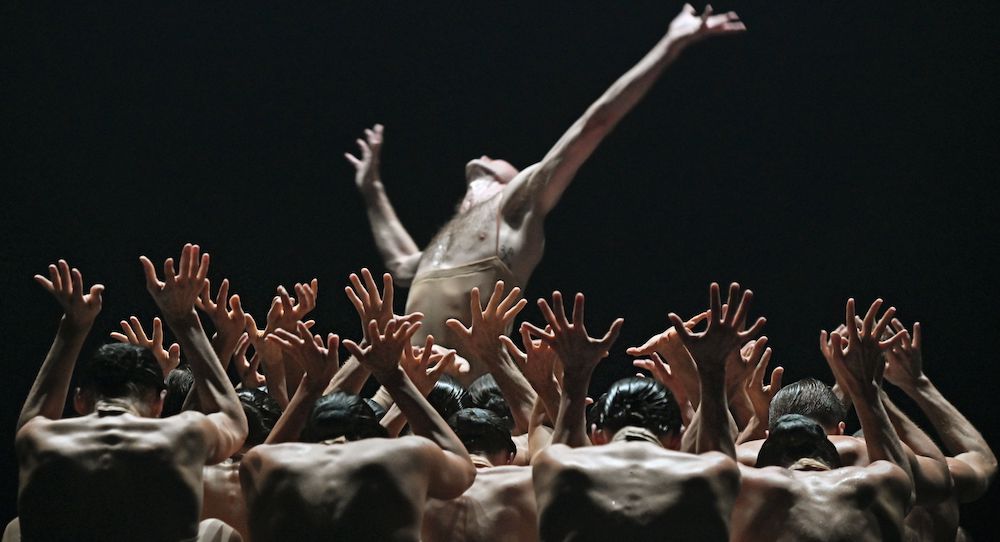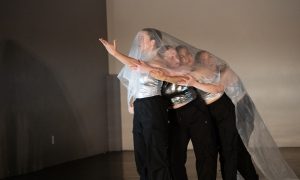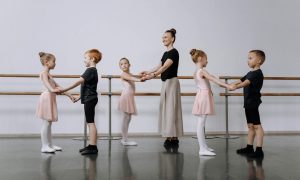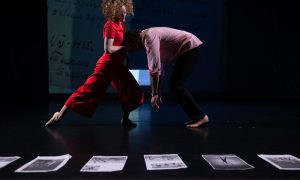The Joyce Theater, New York, NY.
January 24, 2023.
Dancers stride across the stage in Sharon Eyal’s signature relevé walk (legs mostly straight with knees bending slightly upward between steps), hands framing their belly button and elbows symmetrically akimbo. Although there is something fashion show about their diagonal passes, they wear only nude leotards and knee high socks. Micro head movements, saluting gestures and level changes gradually accumulate on top of their consistent steps, which follow a heavy percussion beat –– the opening of composer Ori Lichtik’s unrelenting electronic soundscape. Some dancers let expression flood their face and even in its pattern-based precision, pleasant, momentary asynchronies reward the attentive watcher. According to the program note, “one can see from the same thing how different we are” –– the absolute uniqueness of each individual. When the full group adds dynamic hip movements to their steps, the choreography’s impressive restraint is rewarded. This is German company, tanzmainz, making its Joyce debut with Sharon Eyal’s Der Faust Award-winning piece, Soul Chain.
The group clusters together, two grooving dancers covered and uncovered by the clump as it breathes in and out. The stepping never stops –– even the breakout solos maintain its steady rhythm –– and from magnetic grand plié chest pops to arch toss lifts to sharp pulsing cat-cows (with one dancer looking front, a focus motif which occurs a few times throughout the piece), the movement feels very unfree for all its groove. Eyal says she creates based on what’s intuitive in the moment, “almost like an animal.”
Despite the apparent beating hearts before me and the humanity implied by the idea of nudity that’s built into the costumes, I feel like I’ve entered the uncanny valley; so-called animalistic movement is tempered by its cleanliness and feels more related to Artificial Intelligence than something truly “natural.” If these dancers are anything other than humanoid, then they must be insects, a colony of insects working together in spastic synergy. The work is overwhelmingly frontal, and I’m left wondering, “Who is the audience to these dancers? Why are they performing for us?” Perhaps we are the collective queen of the ant colony.
Around a third of the way into the piece, a female dancer breaks from the group to perform an Eyal-walk-inspired solo on the spot as the others fade into darkness upstage. Her neck is mobile and her body pulses with energy, but the solo seems to go on longer than any previous section and she stays away from the group even after she’s no longer the feature. It somehow feels like she’s been ousted as the group performs abrupt shifts with astounding control. A dancer front center does a series of backbreaking ring kicks, and even as the footwork complexifies, there’s a lot of space holding in the rest of the body. When the group finally spreads out, the soloist is reintegrated and I can’t help but feel a sense of relief.
After a spatially complex beginning, there are now almost no formation changes. The movement also rarely reflects the changes in the music, and the ceaseless beat never noticeably changes tempo. At least one dancer steps to the rhythm at all times, and the piece’s unyielding precision leaves no room for error (unless the dancer owns their mistake enough to render it imperceptible to the audience). The intimate details of the dancers breathing and sweating, amplified by the costuming and simpler moments in the choreography, add another layer to the work’s development.
A male dancer bobbles his head from side to side for what feels like an eternity. It starts to become confusing to look at, and reminds me of the experience of saying the same word over and over again until it no longer makes sense. Repetitious voices in the music also start to sound like they’re chanting specific words (2010? Who needs that?) –– am I going insane?
Minutes later, only the bobble-headed dancer is moving, and I feel genuine worry for his neck, which has been drilling the beat for several long minutes. The discomfort of predictability is palpable as I wait for the relief of it stopping. Another long clump section featuring a dancer jumping dramatically in the back shows the dancers as cogs in a complex machine –– but even cogs have their individuality. As the group moves upstage, the dancer’s neck bobbles grow bigger and bigger, involving more of his body. The energy rises as the curtain slowly falls and the music fades out.
According to Eyal, “We find a big loneliness in us confronted with the love of life… Everyone is living their own life and is ending it alone. Soul Chain represents a creation about desire. You see the pain, the sweat, how the inner being is trying to find its way to the outside… Basically it’s all about love, about the love to the others, to yourself, to the space which surrounds you, love to everything. Love is like tissue.”
This is a beautiful sentiment, but upon leaving the theater, the last thing on my mind is love. Instead, the movement feels fortified –– not quite held, but not raw either. The marching dancers that echo through my mind feel militant, cultish, almost sexy, but certainly not held together by love. Nevertheless, Soul Chain certainly left me with plenty to think about.
By Charly Santagado of Dance Informa.















